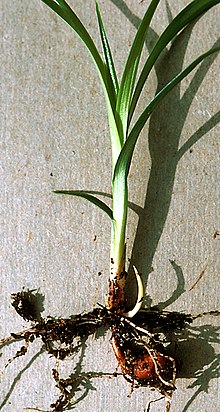Cyperus esculentus
| Chufa sedge | |
|---|---|
 |
|
| Scientific classification | |
| Kingdom: | Plantae |
| (unranked): | Angiosperms |
| (unranked): | Monocots |
| (unranked): | Commelinids |
| Order: | Poales |
| Family: | Cyperaceae |
| Genus: | Cyperus |
| Species: | C. esculentus |
| Binomial name | |
|
Cyperus esculentus L. |
|
| Synonyms | |
|
Synonymy
|
|
Cyperus esculentus (also called chufa sedge, nut grass, yellow nutsedge, tiger nut sedge, or earth almond) is a crop of the sedge family widespread across much of the world. It is found in most of the Western Hemisphere, as well as Southern Europe, Africa, Madagascar, the Middle East, and the Indian subcontinent. Historically it has become naturalized in many other regions, including Ukraine, China, Hawaii, Indochina, New Guinea, Java, New South Wales, and various oceanic islands.
Cyperus esculentus can be found wild, as a weed, or as a crop. Evidence exists for its cultivation in Egypt since the sixth millennium BC, and for several centuries in Southern Europe. In Spain, C. esculentus is cultivated for its edible tubers, called earth almonds or tiger nuts, for the preparation of horchata de chufa, a sweet, milk-like beverage. However, in most other countries, C. esculentus is considered a weed.
It has been suggested that the extinct hominin Paranthropus boisei, the "Nutcracker Man," subsisted on tiger nuts.
Prehistoric tools with traces of C. esculentus tuber starch granules have been recovered from the early Archaic period in North America, from about 9,000 years ago, at the Sandy Hill excavation site at the Mashantucket Pequot Reservation in Mashantucket, Connecticut. The tubers are believed to have been a source of food for those Paleo-Indians.
Zohary and Hopf estimate that C. esculentus "ranks among the oldest cultivated plants in Ancient Egypt." Although noting that "Chufa was no doubt an important food element in ancient Egypt during dynastic times, its cultivation in ancient times seems to have remained (totally or almost totally) an Egyptian specialty." Its dry tubers have been found in tombs from predynastic times about 6000 years ago. In those times, C. esculentus tubers were consumed either boiled in beer, roasted, or as sweets made of ground tubers with honey. The tubers were also used medicinally, taken orally, as an ointment, or as an enema, and used in fumigants to sweeten the smell of homes or clothing. There are almost no contemporary records of this plant in other parts of the old World.
...
Wikipedia
